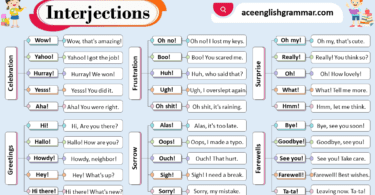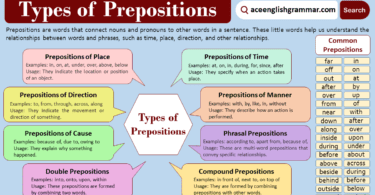Verbs are one of the most essential parts of speech in the English language. They express actions, occurrences, or states of being and form the backbone of almost every sentence. Whether describing an action like “run” or a state like “exist,” verbs help us convey meaning in our sentences. There are many types of verbs, each serving unique purposes. Understanding these types is crucial for both speaking and writing effectively. Let’s dive into what verbs are, their different types, and how to use them with clear examples.
Table of Contents
What Are Verbs?
A verb is a word that expresses an action, occurrence, or state of being. Verbs are essential in forming sentences because they show what the subject is doing or experiencing.
Examples of Verb Usage in Tenses:
- Present tense: She runs every morning.
- Past tense: He ate lunch an hour ago.
- Future tense: They will write a report tomorrow.
- Progressive aspect: I am reading a book.
- Perfect aspect: She has completed her assignment.
Without verbs, sentences would be incomplete and confusing.
Types of Verbs
Verbs can be classified into various categories based on their roles and how they function in sentences. Here’s a breakdown of the most important types of verbs:
Action Verbs
Action verbs describe what the subject of a sentence does, either physically or mentally. These are the verbs that tell us what someone or something is doing. Action verbs can be either physical actions (e.g., run, jump, eat) or mental actions (e.g., think, dream, imagine).
Physical Action: She runs in the park.
Mental Action: He thinks carefully.
Mixed Example: They study hard.
More Examples:
- He writes a letter to his friend.
- They play soccer after school.
- She reads a book in the library.
Linking Verbs
Linking verbs don’t show action; instead, they connect the subject with more information. These verbs often describe a state of being or condition. The most common linking verbs include am, is, are, was, were, seem, become, and feel.
Example Sentences:
- The flower is beautiful. (“Is” links the subject “flower” to the description “beautiful.”)
- He became a doctor. (“Became” links the subject “He” to his new state as a “doctor.”)
- She feels tired. (“Feels” connects “she” to the adjective “tired.”)
Common Linking Verbs:
is, am, are, was, were, seem, become, appear, feel, sound, look, taste, smell, remain, stay, turn, grow, prove
Helping Verbs (Auxiliary Verbs)
Helping verbs assist the main verb in a sentence by forming different tenses, moods, and voices. The primary helping verbs are be (am, is, are, was, were), have (has, have, had), and do (does, did). These verbs often appear with another verb to clarify when an action takes place or to add emphasis.
Examples:
- He is playing cricket. (Present continuous tense with “is” helping the verb “playing.”)
- She has eaten lunch. (Present perfect tense with “has” helping the verb “eaten.”)
- They did not attend the meeting. (“Did” helps to form the negative sentence.)
Modal Verbs
Modal verbs are special verbs used to express abilities, possibilities, permissions, or necessities. Common modal verbs include can, could, may, might, shall, should, will, would, and must. They help us to convey additional meaning in a sentence.
Examples:
- She can speak Spanish. (ability)
- Could you please pass the salt? (polite request)
- Shall we go for a walk? (suggestion)
- You should study for the test. (advice)
- I will call you tomorrow. (future action)
Transitive Verbs
Transitive verbs require a direct object to complete their meaning. These verbs answer the question “what?” or “whom?” and transfer the action from the subject to the object. For example, in the sentence “She eats pizza,” “eats” is a transitive verb because it requires the object “pizza” to complete its meaning.
Examples:
- She kicked the ball. (“Kicked” is the action, and “ball” is the object.)
- He wrote a letter. (What did he write? A letter.)
- I watch movies. (What do I watch? Movies.)
Intransitive Verbs
Intransitive verbs do not need a direct object to complete their meaning. These verbs describe actions that stand alone, without transferring the action to something else. For example, in the sentence “She runs,” the action “runs” is complete by itself.
Examples:
- She runs every morning.
- The baby cried loudly.
- The birds flew away.
Regular and Irregular Verbs
Regular verbs follow a predictable pattern when forming the past tense by adding -ed to the base form (e.g., walk → walked). Irregular verbs, however, do not follow this pattern and have unique past forms (e.g., go → went, see → saw).
Examples:
- Regular Verb: I walked to the store.
- Irregular Verb: I went to school.
Phrasal Verbs
Phrasal verbs are combinations of verbs with prepositions or adverbs that create new meanings. For example, “take off” doesn’t just mean “take” and “off” separately—it means to depart or lift off, like a plane leaving the ground.
Examples:
- Please turn on the lights.
- The plane is about to take off.
- I ran into an old friend yesterday.
Reflexive Verbs
Reflexive verbs indicate that the subject is performing the action on itself. These verbs are paired with reflexive pronouns like myself, yourself, himself, herself, etc.
Examples:
- He hurt himself playing football.
- She washed herself after the game.
- I remind myself to stay calm.
Dynamic Verbs
Dynamic verbs describe actions that are visible or happening in real-time. These verbs show change, progress, or movement, such as run, jump, dance, work, and sing.
Examples:
- He works every day.
- She sings beautifully.
- They run a marathon every year.
Stative Verbs
Stative verbs describe a state or condition rather than an action. They represent situations that are static and generally unchanging, such as emotions, thoughts, or relationships. Examples of stative verbs include like, believe, know, and love.
Examples:
- She knows the answer.
- I believe in fairness.
- He loves his new car.
Key Verb Forms and Tenses
Verbs change forms to indicate the time of the action (tense). Here’s a quick overview of common verb tenses:
- Present: I run.
- Past: I ran.
- Future: I will run.
- Present Perfect: I have run.
- Past Perfect: I had run.
FAQs
A verb is a word that shows an action (run, eat), a state (be, seem), or an occurrence (happen, occur).
The three main types of verbs are:
Action verbs (e.g., write, jump)
Linking verbs (e.g., is, seem)
Helping verbs (e.g., has, will)
Action verbs show what someone is doing, while linking verbs connect the subject to a description without showing an action.
Common helping verbs include is, am, are, was, were, has, have, had, will, shall, can, could, may, might, must.
Yes, some verbs are phrasal verbs (e.g., “give up,” “look after”) and verb phrases (e.g., “has been running”).
Conclusion
Verbs are the backbone of any sentence, expressing actions, states, and occurrences. Understanding different types of verbs—action, linking, and helping—helps in forming grammatically correct sentences. Mastering verbs enhances both writing and speaking skills, making communication clearer and more effective. Keep practicing verb usage to improve your English fluency!
Read More






Leave a Comment